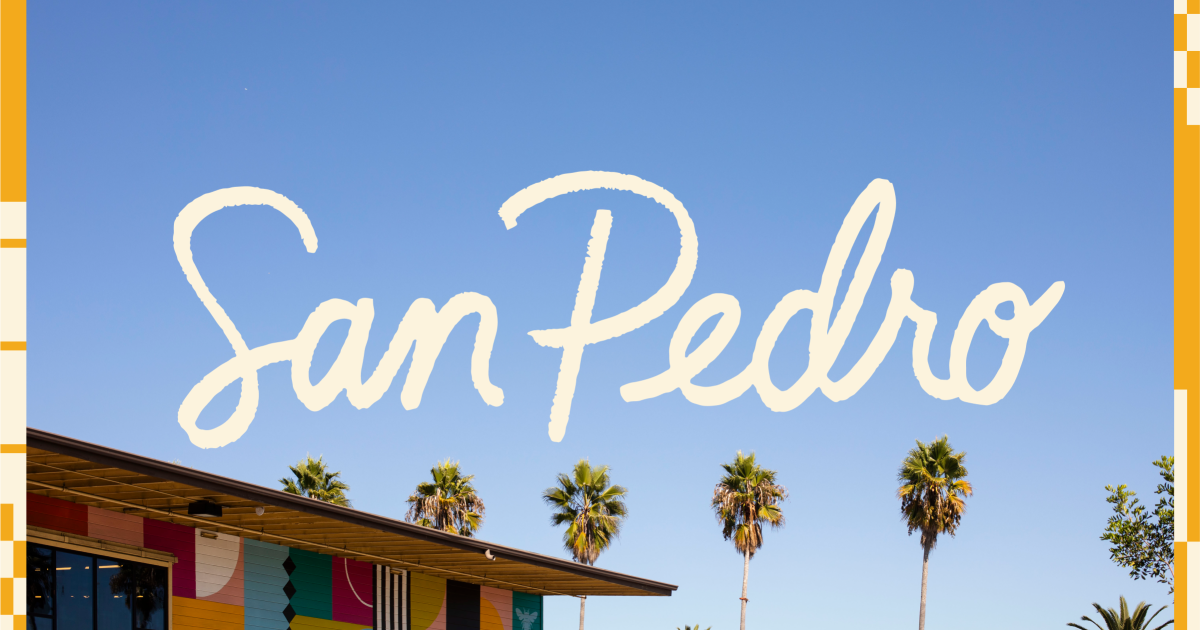Underneath a freeway overpass in San Pedro, where the rumble of cars and semi-trucks echoes from above, there is a hidden skate park. It’s both gritty and mesmerizing, made by a jumble of volunteer hands that have poured concrete, scooped out rain from the storms and artfully assembled every shiny tile of the decorative mosaics that cover the walls of this DIY playground.

Get to know Los Angeles through the places that bring it to life. From restaurants to shops to outdoor spaces, here’s what to discover now.
Gabriel Solis, a 59-year-old retired mason, has come to skate on an early Wednesday morning while his rescue dog watches. He hops off his board to take in the scene.
“I’m an artist and this is my canvas,” he says.
In a way, this underground refuge — the Channel Street Skatepark — feels like a symbol for San Pedro, a city where creativity and community seem to emerge in the most unexpected spaces. Solis, who’s lived there for 20 years, describes the neighborhood with words like “rebellious,” “punk” and “pure.”
“It’s a place where you don’t have to explain yourself,” he says. “Here, I’m Gabe. The people I know in skateboarding, I don’t even know their last names. It’s a culture. We know who you are because you put in the work. That’s what Pedro is. We build stuff here and destroy it with passion.”
Anchored at the southern end of the 110 Freeway, just 25 minutes from downtown L.A., San Pedro (pronounced “San Pee-dro” by those in the know) is an old Navy town once inhabited primarily by longshoremen, dock workers and their families. It’s long had a renegade spirit: In the late ‘70s and early ‘80s, it was the home of a swelling punk scene. (A 1981 Black Flag show at San Pedro High School, with new singer Henry Rollins making a debut with the band, is a moment that the punk forefathers still talk about.) San Pedro is also home to a robust Croatian community — in 2003, a stretch of 9th Street was named “Croatian Place” and every year, in honor of Croatia’s independence from Yugoslavia, a massive, multi-day celebration happens there. And the city consistently attracts creatives. Art flourishes everywhere, from the gallery walls showcased at San Pedro’s First Thursday Art Walk to sidewalks, utility boxes and various urban crevices. (Try to find the many cats around the city painted by an artist mysteriously known as @ifoundyourcat on Instagram.)
At a San Pedro block party, small kids sitting on skateboards roll out of Calimucho Screen Printing shop, while people gather outdoors to listen to the surf band Bombón. There’s a hodgepodge of small business owners selling goods — houseplants, crystals, the San Pedro edition of Monopoly — and they all seem to be friends.
“San Pedro has that small-town vibe,” says filmmaker April Jones, whose documentary “Concrete Law” follows Channel Street Skatepark’s seven-year bureaucratic battle. “I’m friends with my tamale lady. I say ‘good morning’ to the little old lady walking her dog. I give my neighbors hugs.”
While creation is one theme that permeates throughout the city, preservation is another. There’s a fight to protect history here — seen within recent efforts to restore landmarks including the Hey Rookie Pool, Warner Grand Theatre and the Muller House Museum. Yet the sentiment overlaps with the knowledge that massive change is also coming. Work is underway on a 42-acre, $160 million waterfront park and food hall called West Harbor, which is emerging on the former home of the shabby-but-beloved Ports O’ Call Village. Opening in 2025, it features a lengthy lineup of big-name tenants, such as Hollywood’s iconic mountain palace Yamashiro, immersive art experience Hopscotch and chic dog social club Bark Social.
As in all neighborhoods facing transformation, there’s both excitement and apprehension in the air. But one thing’s certain: Whatever San Pedro becomes next, locals will figure out how to make it their own.
See San Pedro for yourself. Here are 15 things to do in the city.
Love where you live? Tell us which neighborhood we should feature next.
What’s included in this guide
Anyone who’s lived in a major metropolis can tell you that neighborhoods are a tricky thing. They’re eternally malleable and evoke sociological questions around how we place our homes, our neighbors and our communities within a wider tapestry. In the name of neighborly generosity, we included gems that may linger outside of technical parameters. Instead of leaning into stark definitions, we hope to celebrate all of the places that make us love where we live.


